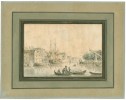[OZANNE (Nicolas ou Pierre).]
[Amsterdam - Scène dactivité maritime / Maritime scene].
s.l.n.d. [Amsterdam circa 1780]. 1780 1 feuille de papier vergé 18éme (145 x 215 mm). Dessin à l'encre et lavis d'encre en 3 tons (noir, bleu, sépia). Cadre en bois doré. Etiquette d'exposition au revers "Ozanne".
Reference : 4752
Beau lavis d'encre en 3 tons, finement exécuté, représentant un quartier dAmsterdam, uvre non signée attribuable à Pierre ou Nicolas Ozanne vers 1780. Placé face à lintersection de deux voies de navigation, lartiste a représenté au premier plan deux marins en habits de pêche, à bord d'une petite embarcation, accostant un pieu d'amarrage. Sur la gauche, des " tjalks " ( navires fluviaux aux formes arrondies à l'avant et à l'arrière) sont stationnés au pied dune rangée de bâtiments bordant un canal. Les façades sont typiques des étroites maisons à étages de la cité, avec leur potence en bois fixée au faîte permettant le chargement des marchandises dans les greniers. Au pied des maisons, des marins circulent sur des passerelles de bois sur pilotis donnant accès aux bateaux. Au fond, au-dessus des toits, on distingue à peine la silhouette du clocher de la " Westerkerk ". Édifice caractéristique par sa structure pyramidale à étages qui demeure l'un des points de repère de la ville dAmsterdam depuis sa construction achevée en 1631. Au centre, une chaloupe manuvrée à 4 avirons s'engage dans le canal aux eaux tranquilles. Sur la droite, un navire arborant le pavillon des Pays-Bas est accosté le long d'un quai de bois. À terre, des dockers actionnent une machine de charge constituée d'une poutre horizontale pivotant sur un mât central et équipée de poulies et d'une roue à rayons. Daprès nos recherches, le quartier de la ville qui correspond le mieux à ce dessin est lintersection de la rivière Amstel avec le canal Zwanenburgwal. (Position du clocher, largeur du canal, habitations sur la gauche, quai dégagé sur la droite, architecture des maisons subsistant). Le papier vergé utilisé est datable de la seconde moitié du 18éme siècle. Travaillant en 3 tons (encres noire, bleue et sépia), lartiste a saisi chaque détail de cette scène dactivité portuaire avec un il de marin, proportionnant avec exactitude chaque élément de la dizaine de navires et embarcations représentés. En bas à gauche subsiste les traces dune signature ou légende devenues illisibles. Cependant, le sujet, le souci du moindre détail (forme des coques, gréements, accastillage) ainsi que les encres utilisées et le style typique permettent didentifier un travail de Pierre Ozanne (1737-1813) (ou de son frère Nicolas), célèbres pour leur uvre maritime et les "60 vues des ports de France" (1775) réalisées à la demande du roi. A notre connaissance, aucune représentation de la célèbre cité hollandaise par Pierre Ozanne ou par son frère Nicolas (1728-1811) nest connue. Cependant, parmi les gravures de navires publiées par Pierre Ozanne figurent des navires hollandais. 1 laid paper sheet (145 x 215 mm). Ink and wash drawing with 3 tones (black, blue and sepia). Beautiful ink wash drawing of Pierre or Nicolas Ozanne, finely executed, representing a district of Amsterdam. Facing the intersection of two shipping lanes, the artist has represented two sailors in the foreground in fishing clothes, aboard a small boat, docking a mooring stake. On the left, some "tjalks" (river vessels with rounded shapes at the front and rear) are stationed at the foot of a row of buildings bordering a canal. The facades are typical of the city's narrow two-storey houses, with their wooden gallows fixed to the ridge allowing the loading of goods in the attics. At the foot of the houses, sailors are passing by on wooden walkways on stilts giving access to the boats. In the background, above the roofs, you can barely make out the silhouette of the bell tower of the "Westerkerk". Characteristic building by its pyramidal structure with stages which remains one of the landmarks of the city of Amsterdam since its construction which was completed in 1631. In the center, a rowboat maneuvered with 4 oars engages in the canal. On the right, a ship flying the flag of the Netherlands is docked alongside of a wooden quay. On the land, dockworkers operate a loading machine consisting of a horizontal beam pivoting on a central mast and equipped with pulleys and a spoke wheel. According to our research, the part of town that best matches this drawing is the intersection of the Amstel river with the Zwanenburgwal canal. (Position of the bell tower, width of the canal, houses on the left, open quay on the right, architecture of the remaining houses). The laid paper used in this drawing can be dated back to the second half of the 18th century. Working with 3 tones (black, blue and sepia inks), the artist captured every detail of this maritime scene with a sailor's eye, accurately proportioning each element of the ten ships and boats represented. At the bottom left, there are traces of a signature or legend which have become illegible. However, the subject, the attention to the smallest detail (shape of the hulls, rigging, fittings ...) as well as the inks used and the typical style allow to identify a work of Pierre Ozanne (1737-1813) (or his brother Nicolas) , famous for their maritime work and the "60 views of the ports of France" (1775) produced at the request of the king. To our knowledge, no representation of the famous Dutch city by Pierre Ozanne or by his brother Nicolas (1728-1811) is known.
Bookseller's contact details
J-F Letenneur Livres Rares
M. Jean-François Letenneur
11 bd du tertre Gondan
35800 Saint Briac sur Mer
France
librairie@jfletenneurlivresrares.fr
06 81 35 73 35
 Write to the booksellers
Write to the booksellers

